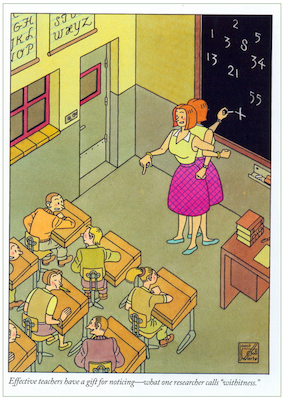Teacher Withitness

As I ruminate on my weaknesses as a teacher, I thought I would share some of the information on the Internet about teacher withitness (with-it-ness).

What is teacher withitness? It’s a skill that teachers have that allows them to know what is going on in the classroom at all times.
Parents of multiple children, former camp counselors, former babysitters, and others with similar experiences have already learned this skill. Since I am the parent of an only child, however, I tend to miss out on some of the activities going on in the classroom. That’s when I usually hear something like, “Mrs. E.! She’s mean to me!”
It is at moments like this that I wish my best friend’s mother (a mother of seven children) were with me. She has eyes in the back of her head, as the saying goes, and can manage her brood of 21 grandchildren with ease. Fortunately, I will become better at this over time, especially since I am aware of my limitations in this area and I know I need to learn more to improve. I have already noticed improvement in the short time I have been a substitute teacher.
This paragraph sums up the skill well.
Withitness is the capacity to perceive the needs of your students with accuracy and care. Teachers who use withitness notice the behavior of all students and respond quickly to unexpected events. They pay close attention to students’ nonverbal and verbal responses. When events deviate from expectations, a teacher who uses withitness responds by changing pace in a lesson, moving about the room, and interacting with students in an effort to redirect and refocus attention and learning (“Withitness – WikEd”, 2008).
How can we improve our withitness skills?
Create the opportunity to practice in your classroom.
- Look at your classroom layout. Are you able to see what is going on everywhere in the room from your position? If not, rearrange the room so you have a clear line of sight to each child at all times. A quick search on Google turned up a page of classroom tours created by Angela Watson (Watson, 2011).
- Evaluate the rules you have established in the classroom. Are there any you need to change? Are there any you aren’t following, though you said you would? Human beings have this tendency to find the flaws in a plan and use those flaws to their advantage. If you are not following the rules you have created, the students will think they do not have to either.
- Observe the students when they enter the classroom and note how well you relate to them. Are there things you should change about your behavior to create better relationships with your students? Teacher withitness and student – teacher relationships are closely related. The better the relationships, the better the learning environment.
Evaluate your current skill set.
- Videotape yourself teaching. One teacher on WikEd (“Withitness – WikEd,” 2008) videotaped himself teaching and found that his ability to manage the classroom dwindled as the day progressed. His last class of the day was the most difficult to manage. Some teachers might think it is because of the group of students in the class or just because it is the end of the day. However, this teacher found out that his withitness skills were not as sharp during that period as they had been in previous classes. He made some adjustments to his classroom-management strategy for that class.
- Ask a colleague to observe. Since many of us will not be allowed to video our classes, having a colleague observe is a good alternative.
Use the resources on the Internet.
- Google Scholar. Without this site from Google, I don’t think I would have made it through my graduate school programs. Scholar should give you quite a few references to pick from for further study on teacher withitness. If you did not know this already, you can also set up Scholar to find links to the articles in the USC library and to export article citations to your favorite citation manager, such as EndNote. Click on this link to go to the article that explains this feature.
- Teaching Channel. You must bookmark this site! There are numerous videos on this site that will help you with everything teaching-related. For articles and videos related to withitness, search for “classroom management.”
- Teacher Vision. This site has a plethora of teacher time-savers. It also has a number of resources for classroom management.
- Education World. I love this site, too, for the bounty of resources available. Here’s a link to their classroom management articles. Here’s a link to their classroom management articles.
I hope you found this post helpful. I would love to read about some of the resources you found!
References Cited in the Article without Links to the Website
Watson, A. (2011). Classroom Tours | The Cornerstone. The Cornerstone. Retrieved November 28, 2011, from http://thecornerstoneforteachers.com/free-resources/classroom-tours
Withitness – WikEd. (2008, March 8).WikEd. Retrieved November 28, 2011, from http://wik.ed.uiuc.edu/index.php/Withitness
—
Image used above is from the December 15, 2008 issue of the New Yorker, via The One Who’s With It Par Excellence – artwork © Joost Swarte
If you’d like to know about MAT@USC and our Master of Arts in Teaching program, contact our Admissions office at 888-628-1872 or email us.


